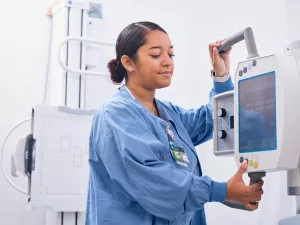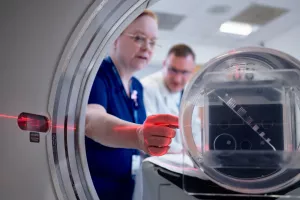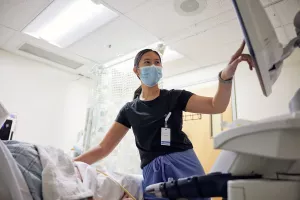An X-ray is a fast, easy and painless imaging test that produces pictures of the inside of your body. Make no bones about it, we’ll treat your health as a top priority and can evaluate any possible bone injuries and so much more with an X-ray.
X-ray marks the spot
X-rays can be routine exams like yearly X-rays with your dentist to check out your smile. Or, they can warrant an emergency trip to the doctor for a suspected broken bone. Whatever the case may be, X-rays are the go-to diagnostic imaging tests if your doctor believes a bone injury is possible.
X-rays use a small dose of radiation to create images of the inside of your body. Dense structures like bones absorb more electromagnetic energy beams than skin, muscles and other soft tissues. That’s why bones appear light gray or white against a dark background in X-rays.
While X-rays aren’t the most colorful pictures you’ll ever take, the high contrast allows doctors to see if anything is out of the ordinary.

Conditions
Doctors will take your health history into account when deciding how to treat your injury. For instance, are you an athlete? What’s your age? Do you have an underlying medical condition?
Your bones have a hard, exterior shell known as a cortex and a spongy cancellous bone (think: honeycomb-like structure) on the inside. The fractures you usually see on X-ray affect both parts of the bone.
In addition to broken bones, we often turn to X-rays to check for the following conditions:
It’s important to note that some injuries may be invisible on the X-ray, like:
- Fractures to cancellous bone (common in overuse or stress fractures)
- Ligament sprains
- Tendon tears
That’s when your healthcare provider may consult with radiologists to determine the best next test to determine the type and extent of your injury.
Testing
An X-ray machine takes images of various interest areas inside your body, like your chest, arms, legs and even your mouth.
Immediately alert your doctor if there's any chance you're pregnant. Although X-rays aren't considered a serious risk for pregnant people, your doctor may choose to err on the safe side and reschedule an X-ray if it's not urgent or medically necessary.
What to expect during an X-ray
The X-ray technologist may have you wear a lead apron to protect other areas of your body from unnecessary radiation.
If a medical condition or an injury prevents you from standing comfortably, the X-ray technologist will help you find an alternative position.
After the procedure, we'll ask you to wait briefly while the technologist determines whether the images are clear enough to make a diagnosis. If the X-rays are blurry or unclear, we'll snap some more pictures.
A radiologist will review the X-ray images and send a full report to your doctor, who will discuss the results with you.

From regular office visits to inpatient stays, find the healthcare you need and deserve close to home.

Meet the doctors and care team devoted to supporting you every step of the way along your path to better health.